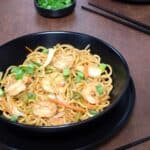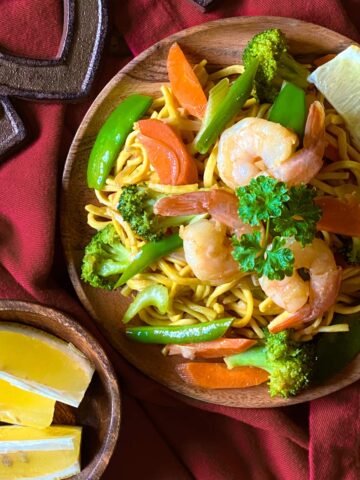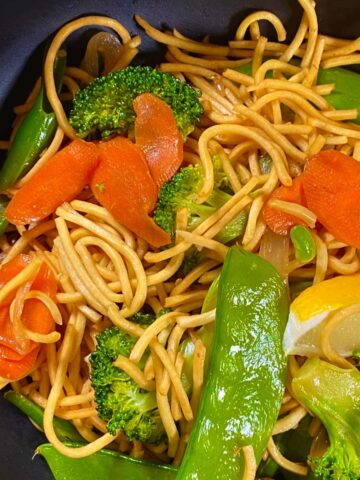Embarking on a culinary journey into the world of Asian noodles offers an exciting gastronomic experience. Among the popular types of noodles are rice noodles and egg noodles. Although both staples in Asian cuisine, they have their unique characteristics. This article aims to navigate the main differences between these two types of noodles, unraveling the complexity of the world of noodles.
Love noodles? Be sure to check out my recipes for Pancit Canton noodles and Pancit Guisado noodle recipes. For a non-meat option, I also have a recipe for Vegetable Filipino Pancit noodles that is quick and easy to make. And if you're wondering how you can freeze pancit be sure to read my article about it.
Jump to:
What They Are
Rice Noodles: As the name suggests, rice noodles are made predominantly from white rice flour and sometimes, tapioca starch. In various forms, they can be thin like vermicelli noodles, or wide rice noodles. Often found in dishes like pad thai and spring rolls, they are a staple in many Asian markets.

Egg Noodles: Chinese egg noodles are made from simple ingredients like egg yolk and wheat flour. Durum wheat is not uncommon in its composition. These are found in Chinese cuisine, particularly in chow mein noodles and lo mein noodles. Fresh egg noodles are a delight, but they also come in dried noodle forms.

Nutritional Differences
Carbohydrate Content: Rice noodles, primarily made of rice, have a higher glycemic index, which can affect blood sugar levels. On the other hand, traditional egg noodles, being wheat noodles, might have a lower glycemic index but still present concerns for individuals with celiac disease.
Protein Content: Egg noodles have a slightly higher protein content due to the addition of egg yolk. In terms of nutrition, this makes them a good choice for those watching their protein intake.
Fat Content: Grams of fat are often lower in rice noodles, making them suitable for low-fat food enthusiasts.
Texture, Taste, and Cooking
Texture: Fresh rice noodles offer a soft and slightly chewy texture, while egg noodles, especially when stir-fried, can be more robust and have a denser bite. Fresh noodles, irrespective of their type, always bring a unique texture to dishes.
Taste: Egg noodles have a richer taste due to the presence of egg yolk. In contrast, rice noodles offer a subtle flavor, making them versatile in soaking up the taste of dark soy sauce, broths, or other flavors.
Cooking Time: Rice noodles often require just a soak in hot water, while egg noodles might need boiling in warm water. However, some varieties, like instant noodles or fresh noodles, can have varied cooking times.
Health Impacts
For those on a gluten-free diet, rice noodles, especially those without the addition of tapioca starch, are the better choice. Wheat noodles contain gluten, which can be problematic for those with celiac disease. Moreover, rice noodles might be the better option for low-calorie diets, given their generally lower-calorie content. However, personal preference and health considerations, like weight loss objectives or managing blood sugar levels, play a significant role in deciding the better choice.
Popular Uses in Dishes
Rice Noodles: Popular in Thai noodle dishes like pad thai, these noodles also feature prominently in Vietnamese cold salads and spring rolls. They come in different shapes, from noodle sheets to rice stick forms, and are often used in stir-fry dishes as well.

Egg Noodles: From noodle soups to stir-fries, egg noodles dominate the Chinese cuisine scene. They can be found in various types of noodle dishes, like chow mein and wonton noodles. They are also frequently used in noodle soups, flavored with simple or rich broths.

Choosing between rice and egg noodles largely hinges on personal preference and dietary needs. While egg noodles offer more protein, rice noodles are a gluten-free alternative. The vast world of Asian noodles offers an array of textures, flavors, and culinary experiences. Ultimately, it's about exploring these differences and enjoying each dish's unique qualities.
Noodle Recipes
Looking for other noodle dishes? Try these:
Other Dishes That Would Go Well With Noodles
These are fan favorite dishes to serve with noodles:
How-To Instructions

Instructions
Rice Noodles
- Nutritional: Primarily made of rice, it has a higher glycemic index, which can affect blood sugar levels. Grams of fat are often lower in rice noodles, making them suitable for low-fat food enthusiasts.
- Texture: Fresh rice noodles offer a soft and slightly chewy texture.
- Taste: Rice noodles offer a subtle flavor, making them versatile in soaking up the taste of dark soy sauce, broths, or other flavors.
- Cooking Time: Rice noodles often require just a soak in hot water.
Egg Noodles
- Nutritional: Traditional egg noodles, being wheat noodles, might have a lower glycemic index but still present concerns for individuals with celiac disease. Egg noodles have a slightly higher protein content due to the addition of egg yolk.
- Texture: Egg noodles, especially when stir-fried, can be more robust and have a denser bite.
- Taste: Egg noodles have a richer taste due to the presence of egg yolk.
- Cooking Time: Egg noodles might need to be boiled in warm water.



























Mandy
I love this guide! Noodles are very versatile and I like to change it up between rice and egg noodles. Great tips. Thank you!